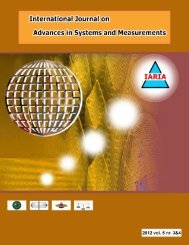download vol 5, no 3&4, year 2012 - IARIA Journals
download vol 5, no 3&4, year 2012 - IARIA Journals
download vol 5, no 3&4, year 2012 - IARIA Journals
Create successful ePaper yourself
Turn your PDF publications into a flip-book with our unique Google optimized e-Paper software.
International Journal on Advances in Telecommunications, <strong>vol</strong> 5 <strong>no</strong> 3 & 4, <strong>year</strong> <strong>2012</strong>, http://www.iariajournals.org/telecommunications/<br />
(4) Network Interconnection Agreements (NIA): between<br />
the Network Providers or between NPs and CANPs; these<br />
are <strong>no</strong>t new ALICANTE functionalities but are necessary for<br />
NP cooperation.<br />
After the SP negotiates a desired VCAN with CANP, it<br />
will issue the installation commands to CANP, which in turn<br />
configures, via Intra-NRM (action 5), the MANE (Media<br />
Aware Network Element) functional blocks (input and<br />
output).<br />
OL<br />
5<br />
MANE<br />
HB/CS<br />
CAN RM<br />
SLS<br />
1<br />
CAN<br />
Manager<br />
2<br />
Intra-NRM<br />
@NP<br />
Access<br />
Network<br />
AS1<br />
Service<br />
Manager@SP<br />
3<br />
NIA<br />
Multi-domain VCAN<br />
QoS enabled<br />
MANE<br />
SLS<br />
4<br />
MANE<br />
Service<br />
Provider<br />
CAN<br />
Manager<br />
Intra-NRMr<br />
@NP<br />
AS2<br />
HB + SP<br />
Environment<br />
MANE<br />
Home<br />
Network<br />
CANP :<br />
CAN<br />
Layer<br />
Network<br />
Layer<br />
Access<br />
Network<br />
HB<br />
EUT<br />
Figure 1 High level ALICANTE architecture: multi-domain VCANs and<br />
main management and control interactions<br />
Notations: OL - Optimization Loop; SLS – Service Level<br />
Specification; NIA - Network Interconnection Agreement;<br />
RM – Resource Management; SP – Service Provider; CANP<br />
Content Aware Network provider; NP - Network Provider<br />
CS- Content Server; Intra-NRM – Intra domain Network<br />
Resource Manager; HB-Home Box; EUT- End User<br />
Terminal; MANE – Media Aware Network Element ; AS –<br />
Auto<strong>no</strong>mous System<br />
IV. CONTENT AWARENESS AND QOS AT CAN LAYER<br />
The Content Awareness (CA) is realized in three ways:<br />
(i) by concluding a SLA between the Service Provider<br />
and CAN provider (SP –CANP) concerning different VCAN<br />
construction. The Content Servers (CS) are then instructed<br />
by the Service Provider to insert (if they are able to do it)<br />
some special Content Aware Transport Information (CATI)<br />
fields in the headers (e.g in the Real Time Protocol header)of<br />
the data packets. How to optimize this insertion is <strong>no</strong>t in the<br />
scope of this paper. This CATI simplifies the media flow<br />
classification and treatment by the MANE;<br />
(ii) SP-CANP SLA is concluded, but <strong>no</strong> CATI can be<br />
inserted in the data packets (this is the case of legacy Content<br />
Servers). The MANE applies deep packet inspection for data<br />
flow classification and assignment to VCANs. The flows<br />
treatment is still based on VCANs characteristics defined in<br />
the SLA;<br />
(iii) <strong>no</strong> SP–CANP SLA exists and <strong>no</strong> CATI. However,<br />
the flows treatment can still be processed in content aware<br />
style, but conforming to the local policy at CANP and<br />
IntraNRM.<br />
The networking tech<strong>no</strong>logies to support QoS enabled<br />
VCANs are DiffServ and/or MPLS. The sets of flows are<br />
splitted in QoS classes (QC), with a mapping between the<br />
VCANs and the QCs. Several levels of QoS granularity can<br />
be established when defining VCANs. The QoS behavior of<br />
each VCAN (seen as one of the parallel Internet planes) is<br />
established in the SP-CANP SLA contract.<br />
Generally a 1-to-1 mapping between a VCAN and a<br />
network plane will exist. Customization of VCANs is<br />
possible in terms of QoS level of guarantees (weak or<br />
strong), QoS granularity, content adaptation procedures,<br />
degree of security, etc. A given VCAN can be realized by the<br />
CAN Provider, by combining several processes, while being<br />
possible to choose different solutions concerning routing and<br />
forwarding, packet processing, and resource management.<br />
The definitions of local QoS classes (QC) and extended<br />
QCs and meta-QoS classes were adopted in ALICANTE,<br />
[16][17][23][25] to allow capturing the <strong>no</strong>tion of QoS<br />
capabilities across several domains. Each domain may have<br />
its local QoS classes and several local QCs can be combined<br />
to form an extended QC. The types of VCANs defined for<br />
different QoS granularities based on QoS Classes are<br />
VCANs based on meta-QCs [16], VCANs based on local QC<br />
composition and hierarchical VCANs based on local QC<br />
composition. The last case is the most efficient but also the<br />
most complex. Inside each VCAN, several QCs are defined<br />
corresponding to platinum, gold, silver, etc. In such a case,<br />
the mapping between service flows at SP level and CANs<br />
can be done per type of the service: VoD, VoIP, Videoconference,<br />
etc.<br />
The definition of QoS classes makes the system robust to<br />
traffic overload with protection of desired flows against such<br />
overloads. Actually the QoS support for the real-time traffic<br />
in the VCANs are assured by :<br />
- QoS constrained routing and logical reservation of<br />
traffic trunk pipes (provisioned at SP request);<br />
- installation of them in the network (unicast or<br />
multicast mode);<br />
- traffic enforcing rules in the Data Plane.<br />
For unicast VCAN the supporting QoS tech<strong>no</strong>logy is<br />
MPLS cooperating with Differentiated Services (E-LSP<br />
solution). For multicast case QoS constrained trees are<br />
computed, resource reservation is done and then in the Data<br />
plane Diffserv is enforced.<br />
<strong>2012</strong>, © Copyright by authors, Published under agreement with <strong>IARIA</strong> - www.iaria.org<br />
177







